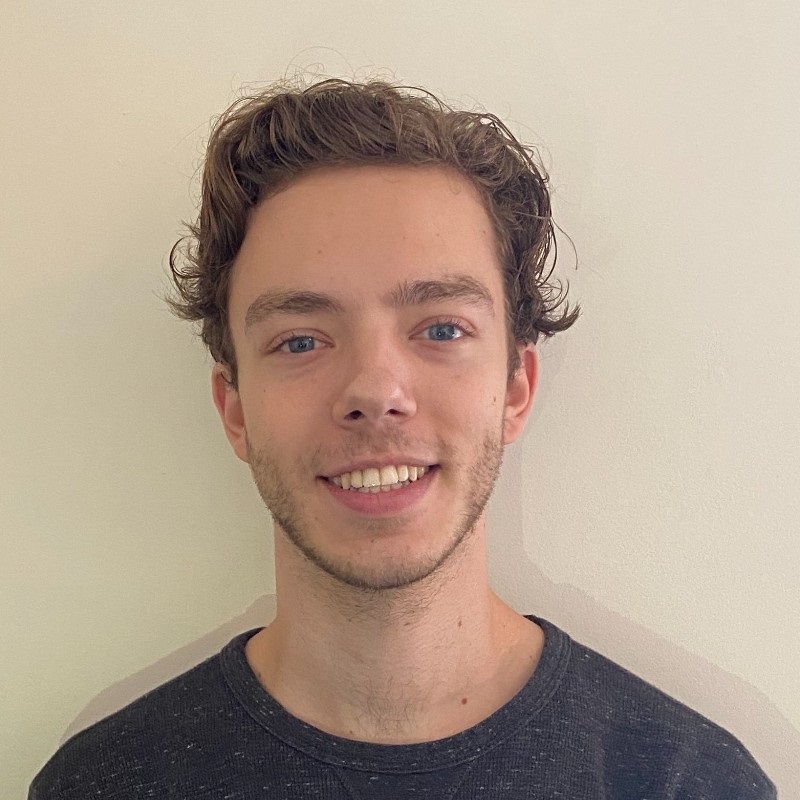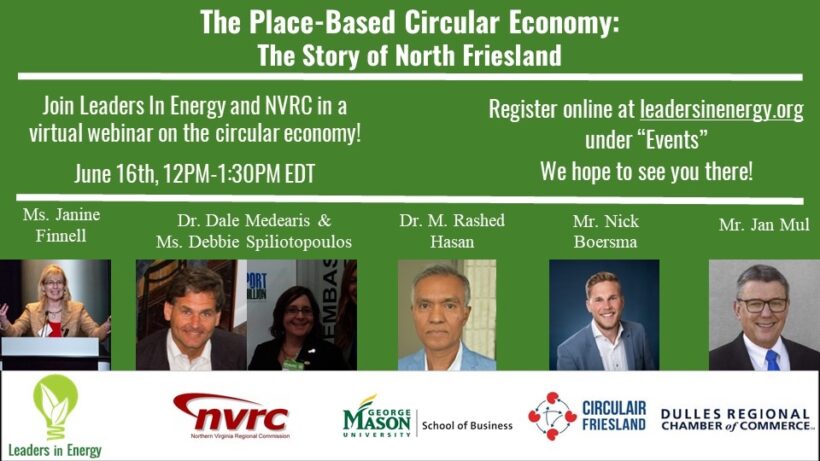
By Brandon Licata
In June 2022, Leaders in Energy (LE), the Northern Virginia Regional Commission, and Circular Friesland co-hosted a webinar on “The Place-Based Circular Economy: The Story of Friesland.” This webinar looked at ways that the experiences with orchestrating a “circular economy” from the Dutch region of North Friesland might apply to Northern Virginia. The panel of experts included Janine Finnell, Executive Director for LE, Dale Medearis and Debbie Spiliotopoulos, Regional and Senior Environmental Planners for NVRC, Nick Boersma and Marije de Boer, representatives for the CFA, Jan Mul, Director of International Business Investment at the Dulles Chamber of Commerce and Fairfax County Economic Development Authority, and Rashed Hasan, Executive-in-Residence for the Business for a Better World Center at George Mason University (GMU). The panelists collectively represented important institutions needed to create and sustain a circular economy.

So, what exactly is the circular economy and how does a circular economy function in the Netherlands ? In short, a circular economy is a system that mirrors elements of the natural ecosystems; a system in which little is wasted and excess materials from one process serve as resources for another. According to The Circularity Gap Report 2021 by Circle Economy, the global economy is currently about 8.6% circular. The report points out that increasing the level of “circularity” to at least 17% by 2032 could possibly reduce carbon emissions enough to meet the 2 degrees Celsius target of the Paris Climate Accords. The experiences of North Friesland suggest that a circular economy meets the triple bottom line of economic, social and ecological sustainability – and the smarter, more efficient option for Northern Virginia and the planet. A circular economy consumes fewer virgin materials and extracts a higher value from materials we do use.
Some background about the CFA. The CFA was started in 2016, and Friesland was named the most circular region in the Netherlands by 2017. By 2021, Circular Friesland had over 120 members. The “triple helix” approach of business, government, and academia is critical to Circular Friesland’s strategy. Each of these sectors bring important strengths to the association, and the specific knowledge they hold pertaining to the province of Friesland is a great example of why tackling specific regions is oftentimes superior to a nationwide approach. A smaller scale project offers the benefit of a more doable task with specific strategies designed for the region at hand.
Circular Friesland finds their foundational principles in Metabolic’s 7 Pillars of the Circular Economy and focuses primarily on five sectors: plastics, launching customership, water technology, agriculture, and construction. CFA takes a multifaceted approach to affecting change in these sectors, but their most important focus is their member program. The foundation of any movement is the people fueling the work. Leaders in Energy shares this focus on members as a global action network and connecting platform designed to help people passionate about sustainability network to make a difference all over the world.
In Northern Virginia, the panel of experts shared their expertise about the potential to apply the lessons of the CFA to Northern Virginia. A critical start is the convening of economic and financial research by elected leaders to nurture creative enthusiasm around the core concepts of circularity. Dr. Rashed Hasan, pointed out that companies from Europe through their subsidiaries in Northern Virginia could provide a framework for circularity concepts given their long-term history with sustainability planning that fused together environmental, economic and social goals. This starts when there is a shared understanding about what makes businesses sustainable, and the important considerations of living wages, community involvement and concrete quantitative benchmarks. Ms. Debbie Spiliotopoulos raised the important environmental issue of capacities at landfills in Northern Virginia and the rest of the Commonwealth for receiving construction waste. Ms. Spiliotopolous suggested that this is a problem that business and local governmental partnerships can address together – especially in contexts that reflect Circulair Friesland’s triple helix approach.
Mr.Jan Mul built on the insights of Ms. Spiliotopolous and Dr. Hasan by adding that a region’s sustainability practices can be a major global marketing tool for the region to lure prospective and sustainable tourism, trade and business investment. Mr. Mul spoke to the importance of focused engagement in a global economic dialogue – especially at the regional level. He further emphasized the potential for Northern Virginia to become among the most sustainable regions in the United States through applying circularity concepts from the model of North Friesland.
Applying the lessons of circularity from the Netherlands will not be easy. There will be regulatory, environmental, technical, cultural and political constraints such as seen with the recent rollback of proposed legislation to reduce single-use plastics in Virginia. In closing their presentation, Boersma and de Boer inspired confidence that circularity is not an overly ambitious goal for the United States. He paraphrased a lesson imparted by Jan Rotmans, Professor of Transition Management at the School of Social and Behavioral Sciences at Erasmus University in Rotterdam. Prof. Rotmans found that 5-10% of the population changes after a crisis, and the global community has experienced no shortage of crises in the past few years, most notably the COVID-19 pandemic and the recession that followed. Prof. Rotmans also believes that, in order to make large-scale transitions, the global economy needs 25% of the population to be amenable to making these changes. The task of creating a more circular world suddenly appears much more within reach. Convincing one in four people is a manageable undertaking. Leaders in Energy and Circular Friesland both share the mission of connecting people and spreading the word about the environmental challenges the planet faces.
This was a truly informative and inspiring webinar. Follow-up is already underway. Leaders in Energy is currently developing a circularity roadmap for the District of Columbia, Maryland, and Northern Virginia area. This should indicate to many that there are grounds for optimism in the pursuit towards sustainability. There are many great examples all over the world with whom we can work and continue to expand a network of like-minded individuals and push towards “The Big Green Shift” and the transformation of work, life, and thought for the planet.
NOTE: The webinar can be viewed at the LE Event Archives along with the presentations by Janine Finnell and Circulair Friesland.
BRANDON LICATA is a 4th year at the University of Virginia studying Global Environments and Sustainability. He has been involved in activism since high school, helping to organize and speaking at Norfolk, Virginia’s March for Our Lives event and being involved in many events with the organization since. During college, Brandon set his sights on environmental issues. He hopes to attend law school after graduating from UVA and focus on environmental law. Brandon believes wholeheartedly in Leaders in Energy’s mission and is excited to be a part of the team as an intern working on newsletters, the Circular Economy Working Group, and other projects.



Leave a Reply